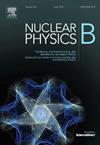中微子与夸克的轴向非标准相互作用模型
IF 2.8
3区 物理与天体物理
Q2 PHYSICS, PARTICLES & FIELDS
引用次数: 0
摘要
中微子振荡实验为矢量非标准中微子与物质场的相互作用(NSI)设定了越来越强的上界。然而,轴向NSI的界限更为宽松,这给人们带来了希望,即在DUNE等实验中研究中性电流事件,可以对新物理学有所了解。我们建立了一个模型,该模型产生轴向NSI,具有较大的耦合,导致与DUNE标准预测的可观察偏差。该模型基于U(1)规范对称,具有质量为~ 30 GeV的规范玻色子,该玻色子可以在高亮度LHC中发现。结合LHC和DUNE的发现,我们可以解开相互作用的轴向形式。测量群异常的取消表明存在新的重夸克和暗物质候选者。与第一代夸克混合的新夸克也可以在大型强子对撞机中发现。此外,它们提供了一个跷跷板机制来解释u和d夸克质量的小。暗物质与夸克具有轴向耦合,这使得通过依赖自旋的直接暗物质搜索实验发现暗物质成为可能。本文章由计算机程序翻译,如有差异,请以英文原文为准。
A model for axial non-standard interactions of neutrinos with quarks
The neutrino oscillation experiments are setting increasingly strong upper bounds on the vector Non-Standard neutrino Interactions (NSI) with matter fields. However, the bounds on the axial NSI are more relaxed, raising the hope that studying the neutral current events at an experiment such as DUNE can give a glimpse on new physics. We build a model that gives rise to axial NSI with large couplings leading to observable deviation from the standard prediction at DUNE. The model is based on a gauge symmetry with a gauge boson of mass ∼30 GeV which can be discovered at the high luminosity LHC. Combining the LHC and DUNE discoveries, we can unravel the axial form of interaction. The cancellation of anomalies of the gauge group suggests new heavy quarks as well as a dark matter candidate. The new quarks mixed with the first generation quarks can also be discovered at the LHC. Moreover, they provide a seesaw mechanism that explains the smallness of the u and d quark masses. The dark matter has an axial coupling to the quarks which makes its discovery via spin dependent direct dark matter search experiments possible.
求助全文
通过发布文献求助,成功后即可免费获取论文全文。
去求助
来源期刊

Nuclear Physics B
物理-物理:粒子与场物理
CiteScore
5.50
自引率
7.10%
发文量
302
审稿时长
1 months
期刊介绍:
Nuclear Physics B focuses on the domain of high energy physics, quantum field theory, statistical systems, and mathematical physics, and includes four main sections: high energy physics - phenomenology, high energy physics - theory, high energy physics - experiment, and quantum field theory, statistical systems, and mathematical physics. The emphasis is on original research papers (Frontiers Articles or Full Length Articles), but Review Articles are also welcome.
 求助内容:
求助内容: 应助结果提醒方式:
应助结果提醒方式:


